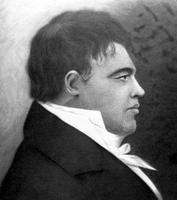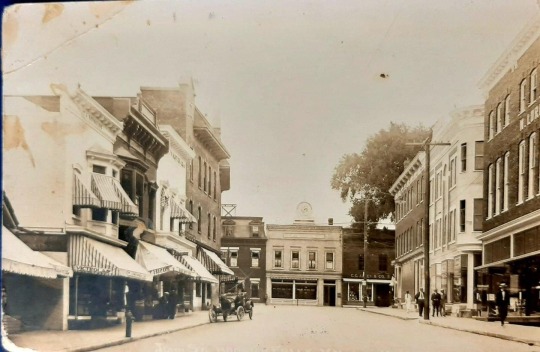Text
Conclusion
After my stressful trial, I finally retired and settled at St Andrews West.

Beautiful right?
I met my wife, Catherine McDonnell and we got married on June 2, 1820 and had nine children altogether. I served as captain of the 1st Regiment of the Stormont Militia during the Rebellions of 1837 until I got handicapped by a serious knee injury.
Currently, I try make ends meetby engaging in multiple enterprisings such as milling and farming. It feels good to blog about my past adventures, reading through my three journals and summarizing. I feel as if this is where it ends now as my days consist only of work to support my family.
I believe in life we have many roles. I once was a fur trader who loved to explore and it was all that I knew. It eventually did get me into trouble, but it lead me to realize that it is okay to be uncomfortable. I knew fur trading was not for me anymore and tried to sustain it for as long as possible, but circumstances showed me that it was time to move on. So I forced myself to become uncomfortable. Moved to place I had never been and was introduced into a new role, husband. And then I became a father and now I am a provider. So as I grow weaker everyday, finding it harder to get up and fulfill my role, one thing that always lingers in my mind is what role will I be remembered by? Son, brother, provider, father, husband, fur-trader, or explorer?
Only time will tell.
0 notes
Text
Map

Reminiscing on my globetrotter days. Here's a map of all my explorations.
0 notes
Text
Life Update
My exploring days were over. I decided I would go on to spend another eleven years actively engaged in the North West Company's fur trade, and was reassigned to the Athabasca Department.
For much of my time, I was in charge of the Mackenzie River District. At this point, I was growing quite weary of fur-trading. I had spent most of my life doing it and have not known a life without it. Not to mention, the rivalry with Hudson Bay Company was getting more violent every second. So the plan was to retire the next year...
Until I was assigned to return to Athabasca for one last winter.

That one winter, I got caught up in a conflict between the North West Company and the Hudson Bay Company shareholders, Thomas Douglas and Lord Selkirk, who established the Red River colony. This resulted in me being amongst the partners arrested by Lord Selkirk at Fort William and charged with complicity in the 1816 Seven Oaks Incident. Funny thing is, I was not even involved in the attack!

I was taken in September to Montreal where I was promptly released on bail. In 1818, I and five other partners were acquitted of all charges related to the incident in the dead colony.

0 notes
Text
Fraser River
The Expansion was successful!
But while I was discovering new locations, I did not realize that I had also discovered a new river!
It was 1808 and I was set on exploring more of this river, which I thought was the Columbia River.

Again, my belief was that we were traveling the Columbia River. I wanted to find out if the river could be used as a fur trade route.
I was aware that in order to do this, I needed the assistance and knowledge of the Indigenous Peoples. During my journey down the Fraser(me) River (which I thought was the Columbia River), I was accompanied by over 20 men which included French-Canadian voyageurs, Scottish clerks, Métis hunters, and Indigenous guides. As the expedition passed through First Nations’ territories, I often sent First Nation representatives ahead of the party to inform the local communities of our imminent arrival and to assure them that the our intentions were friendly. The Indigenous groups us with important information, advice, guides, food, and canoes.

So as I made my final and most arduous journey down the river to the Strait of Georgia, I discovered that we were not on the Columbia River. I knew that the mouth of the Columbia was at 46 degrees, but the latitude was at 49. This was an undiscovered river, later named after me. The Fraser River!
However, do not be fooled. It was not quite a happy ending in the moment. It was a bit of an anticlimax. In fact, in my journal I described the discovery as a "great disappointment in not seeing the main ocean, having gone so near it as to be almost within view.”
Not only was it not the mouth of the Columbia, the river I thought we were descending, but me and my men also met a hostile reception from Musqueam warriors, who promptly chased us upstream all the way to what is now the town of Hope.

Awkward...
0 notes
Text
North West Company
Fast forward to 1789 at 14, I moved to Montreal for additional schooling, where Uncle John was active in the fur trade. Then in 1792, I was apprenticed to the fur-trading North West Company.

Company coat of arms.
In 1801 I was elected one of the company's youngest partners. Then an opportunity came...

In 1805, I was selected to expand the company's operations beyond the Rockies. I got to explore, and it was all funded by the company!
That is when I founded the first European settlements in central British Columbia, establishing Fort McLeod in 1805.

Fort St James

and Fort Fraser in 1806

and Fort George (present Prince George) in 1807

Look!! A bridge named after ME.
I called this area New Caledonia, as it reminded me of my mother’s descriptions of the Scottish Highlands.
1 note
·
View note
Text
Hello World!

Simon Fraser here. I was quite the adventurer back then so I have decided to document my findings. Here's a little get to know me...
I was born on May 20, 1776 in Mapletown, Hoosick Township, New York.

I was the youngest of 10 children. My parents, Simon Fraser of Culbokie and Guisachan, and Isabel Grant of Daldreggan came with his regiment to North America in 1773. But in 1777, father was captured at the Battle of Bennington and died in 1779 as a prisoner in Albany Jail.
Even after the war ended, my family was still being harassed by rebels. That is why mother and us kids moved to Canada with her in 1784. So one of my uncles, Captain John Fraser, one of the brothers who had served in fathers regiment and was a judge, helped us settle near Coteau-du-Lac, west of Montreal.
0 notes